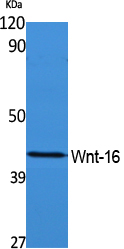Wnt-16 Polyclonal Antibody
- Catalog No.:YT5106
- Applications:WB;ELISA
- Reactivity:Human;Mouse;Rat
- Target:
- Wnt-16
- Fields:
- >>mTOR signaling pathway;>>Wnt signaling pathway;>>Hippo signaling pathway;>>Signaling pathways regulating pluripotency of stem cells;>>Melanogenesis;>>Cushing syndrome;>>Alzheimer disease;>>Pathways of neurodegeneration - multiple diseases;>>Human papillomavirus infection;>>Pathways in cancer;>>Transcriptional misregulation in cancer;>>Proteoglycans in cancer;>>Basal cell carcinoma;>>Breast cancer;>>Hepatocellular carcinoma;>>Gastric cancer
- Gene Name:
- WNT16
- Protein Name:
- Protein Wnt-16
- Human Gene Id:
- 51384
- Human Swiss Prot No:
- Q9UBV4
- Mouse Gene Id:
- 93735
- Mouse Swiss Prot No:
- Q9QYS1
- Immunogen:
- Synthesized peptide derived from the Internal region of human Wnt-16.
- Specificity:
- Wnt-16 Polyclonal Antibody detects endogenous levels of Wnt-16 protein.
- Formulation:
- Liquid in PBS containing 50% glycerol, 0.5% BSA and 0.02% sodium azide.
- Source:
- Polyclonal, Rabbit,IgG
- Dilution:
- WB 1:500 - 1:2000. ELISA: 1:40000. Not yet tested in other applications.
- Purification:
- The antibody was affinity-purified from rabbit antiserum by affinity-chromatography using epitope-specific immunogen.
- Concentration:
- 1 mg/ml
- Storage Stability:
- -15°C to -25°C/1 year(Do not lower than -25°C)
- Other Name:
- WNT16;Protein Wnt-16
- Observed Band(KD):
- 40kD
- Background:
- The WNT gene family consists of structurally related genes which encode secreted signaling proteins. These proteins have been implicated in oncogenesis and in several developmental processes, including regulation of cell fate and patterning during embryogenesis. This gene is a member of the WNT gene family. It contains two transcript variants diverging at the 5' termini. These two variants are proposed to be the products of separate promoters and not to be splice variants from a single promoter. They are differentially expressed in normal tissues, one of which (variant 2) is expressed at significant levels only in the pancreas, whereas another one (variant 1) is expressed more ubiquitously with highest levels in adult kidney, placenta, brain, heart, and spleen. [provided by RefSeq, Jul 2008],
- Function:
- function:Ligand for members of the frizzled family of seven transmembrane receptors. Probable developmental protein. May be a signaling molecule which affects the development of discrete regions of tissues. Is likely to signal over only few cell diameters.,similarity:Belongs to the Wnt family.,tissue specificity:Isoform Wnt-16b is expressed in peripheral lymphoid organs such as spleen, appendix, and lymph nodes, in kidney but not in bone marrow. Isoform Wnt-16a is expressed at significant levels only in the pancreas.,
- Subcellular Location:
- Secreted, extracellular space, extracellular matrix.
- Expression:
- Isoform Wnt-16b is expressed in peripheral lymphoid organs such as spleen, appendix, and lymph nodes, in kidney but not in bone marrow. Isoform Wnt-16a is expressed at significant levels only in the pancreas.
- June 19-2018
- WESTERN IMMUNOBLOTTING PROTOCOL
- June 19-2018
- IMMUNOHISTOCHEMISTRY-PARAFFIN PROTOCOL
- June 19-2018
- IMMUNOFLUORESCENCE PROTOCOL
- September 08-2020
- FLOW-CYTOMEYRT-PROTOCOL
- May 20-2022
- Cell-Based ELISA│解您多样本WB检测之困扰
- July 13-2018
- CELL-BASED-ELISA-PROTOCOL-FOR-ACETYL-PROTEIN
- July 13-2018
- CELL-BASED-ELISA-PROTOCOL-FOR-PHOSPHO-PROTEIN
- July 13-2018
- Antibody-FAQs
- Products Images

- Western Blot analysis of extracts from rat kidney, using Wnt-16 Polyclonal Antibody. Secondary antibody(catalog#:RS0002) was diluted at 1:20000



